|
|
 |
|
 |
| |
Publisher: Chairman Gong-Ru Lin Editors: Professor
Chao-Hsin Wu, Ms. Hsiao-wen Lin October 30, 2014 |
| |
|
 |
|
Congratulations to Professor Chi-Kuang Sun, GIPO, on his being elected the Y. Z. Hsu Scientific Award’s 12th scientific chair professor!
|
Award
|
Category
|
Name |
|
Y. Z. Hsu Scientific Award,12th Scientific Chair Professor |
Optoelectronics Technology |
Professor Chi-Kuang Sun |
Congratulations to Professor Ching-Fuh Lin, GIPO, on his being awarded the Y. Z. Hsu Scientific Award’s 6th technology invention award!
|
Award
|
Invention patent |
Name |
|
Y. Z. Hsu Scientific Award, 6th Technology Invention Award |
Mixed-typed heterojunction thin-film solar cell structure and method for fabrication the same
|
Professor Ching-Fuh Lin |
Congratulations to Professor Gong-Ru Lin, GIPO, on his paper,
“All-optical
modulation based on silicon quantum dot
doped SiOx:Si-QD waveguide”, being published on the journal “Laser and Photonics Review”! For more information, please refer to the following NTU website: http://host.cc.ntu.edu.tw/sec/schinfo/schinfo_asp/ShowContent.asp?num=1180&sn=12524
Congratulations to
Tsung-Jui Yang, a GIPO graduate student, on his being awarded, under the instruction of GIPO professor Yuh-Renn Wu, the “2014 ISNE Best Student Paper Award (oral presentation)”!
|
|
 |
|
 |
|
| |
|
 |
|
May “GIPO Colloquium” Highlights
(Compiled by Li-Chi Yao) |
|
|
3:30 pm, May 2 (Fri.), 2014 |
|
Speaker: |
Dr. Rick Shen (President, eMemory Technology Inc.) |
|
Topic: |
From technology exploitation to it being given authorization to industries |
| |
President Rick Shen visited GIPO on May 2nd (Fri.) and delivered the speech “From technology exploitation to it being given authorization to industries” at lecture theater 101, Barry Lam Hall. His speech was fascinating and content-rich, and the professor interacted well with students. GIPO teachers and students participated in this event with enthusiasm and benefited greatly. |
| |
|
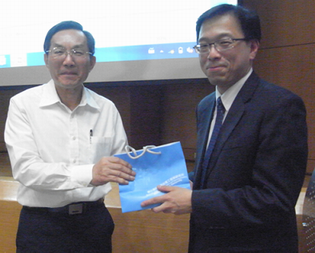 |
|
President Rick Shen
(right), and the host of the
speech, Professor Way-Seen Wang
(left) |
|
|
|
3:30 pm, May 9 (Fri.), 2014 |
|
Speaker: |
Kenneth Tai (Chairman, InveStar Corporation) |
|
Topic: |
Blue Ocean Strategy |
| |
InveStar Chairman Kenneth Tai visited GIPO on May 9th (Fri.) and delivered a speech concerning “Blue Ocean Strategy” at lecture theater 101, Barry Lam Hall. His speech was excellent, and the professor interacted well with his audience. GIPO teachers and students participated enthusiastically and learned a great deal. |
|
|
|
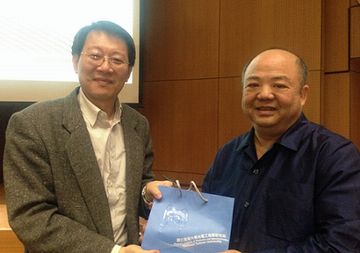 |
|
Chairman Kenneth Tai (right), and GIPO
chairman, Professor Gong-Ru Lin
(left) |
|
|
|
3:30 pm, May 16 (Fri.), 2014 |
|
Speaker: |
Professor Daw-Wei Wang (Department of Physics, National Tsing Hua University) |
|
Topic: |
Taiwanese youths’ future predicaments and challenges |
| |
Professor Daw-Wei Wang visited GIPO on May 16th (Fri.) and delivered a speech concerning “Taiwanese youths’ future predicaments and challenges” at lecture theater 105, EE-Ⅱ Building. His speech was fascinating, and the professor interacted well with students. GIPO teachers and students attended the speech with enthusiasm and learned a great deal. |
|
|
|
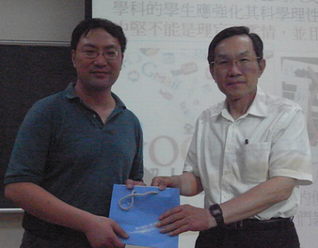 |
|
Professor Daw-Wei
Wang (left), and the host of
this speech, Professor Way-Seen
Wang (right) |
|
|
|
3:30 pm, May 23 (Fri.), 2014 |
|
Speaker: |
Ming-Zen Chien (Chairman, First Financial Assets Management Co., Ltd.) |
|
Topic: |
Practical ways of financing new businesses |
| |
Chairman Ming-Zen Chien visited GIPO on May 23rd (Fri.) and delivered a speech concerning “Practical ways of financing new businesses” at lecture theater 101, Barry Lam Hall. His speech was fascinating and covered a wide-range of issues, and the chairman interacted well with students. GIPO teachers and students found the event to be an interesting and educational experience. |
|
|
|
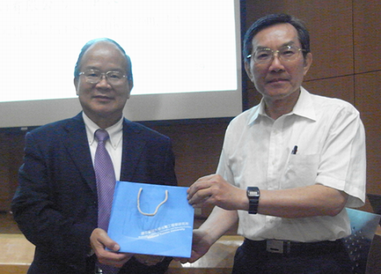 |
|
Chairman Ming-Zen Chien
(left), and the host of this
speech, Professor Way-Seen Wang
(right) |
|
|
|
3:30 pm, May 30 (Fri.), 2014 |
|
Speaker: |
Chun-Ting Liu (General Director, Electronics and Optoelectronics Research Laboratories, Industrial Technology Research Institute of Taiwan, R.O.C.) |
|
Topic: |
The prospective development trend of electronics and optoelectronics’ industries |
| |
General Director Chun-Ting Liu visited GIPO on May 30 (Fri.) and delivered a speech concerning “The prospective development trend of electronics and optoelectronics’ industries” at lecture theater 105, EE-Ⅱ Building. His speech was fascinating, and the speaker interacted well with students. GIPO teachers and students learned a great deal for the event. |
| |
|
|
~ Sidelights on the GIPO Cup sports games, 2014
~
(Time: May 4, 2014;Location: NTU Gymnasium)
Composed by
Ting-Hao Chen, the President of GIPO Student Association
The 2014 GIPO Cup sports games took place on a sunny Sunday afternoon at NTU
Gymnasium. There were 3 types of games
this year, which were the 3-vs-3 street
basketball, the magic free-throw, and
the badminton tournament respectively.
In order to give participants some sort
of surprise, the organizer had refused
to divulge anything about the details of
the magic free-throw to anyone,
regardless of constant inquiries. In
addition to grand prizes for all the top
3 winners, there are also trophies this
year, and so the number of students
registered for these games was extremely high.
3-vs-3 street basketball was the first event to take place. There were 14 teams registered for the game this year, which was played according to elimination rules. To win the shiny and glorious cup, every young player gave it his/her all on the basketball court. Even when the contestants were knocked down, they stood up immediately; their fighting bravery was worth great admiration.
|
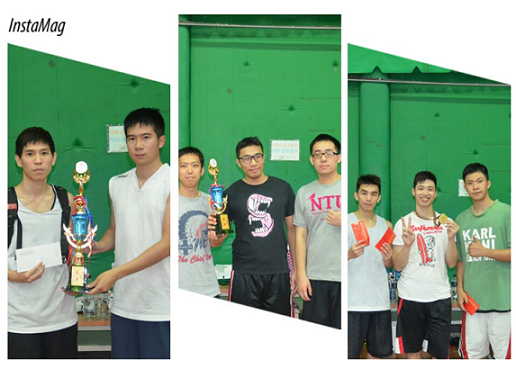 |
|
The top 3 teams in 3-vs-3 street basketball:
The champion: Liang Liao, Yen-An Chen, Wei-Chih Hsu, Po-Han Fu
The 1st runner-up: Yin-Jie Huang, Gong-Sheng Cheng, Sin-Yi Yin, Li-Cheng Chang
The 2nd runner-up: Ming-Chun Lee, Charng-Gan Tu, Danny Weng, Chun-Han Lin |
The next was the magic free-throw. Different from other regular free-throws, which only involve basketballs, this one includes basketballs, volleyballs, soccer balls, shuttlecocks, and tennis balls, for a total of 5 different kinds of balls. Each player threw 3 of each of the 5 kinds of balls, i.e. 15 balls altogether, and the one who threw in the most would win. I also participated in this game, but, unfortunately, threw in merely 4 balls, a number which was far from winning any prize. And, it was really impressive that someone could throw in over 10 balls.
|
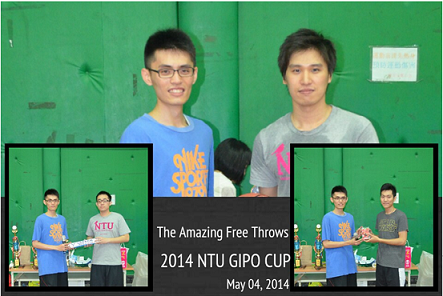 |
|
The top 3 players in the magic free-throw:
The champion: Li-Tien Wei
The 1st runner-up: Sin-Yi Yin
The 2nd runner-up: Wei-Fu Chang
|
The last was the badminton tournament, which was divided into singles and doubles. The game was also played with strict elimination rules, with 7 contestants competing for the singles and 6 teams competing for the doubles. With every player striving to win the prize, there were constant shouts of surprise and support from courtside, and the entire gym was filled with excitement.
|
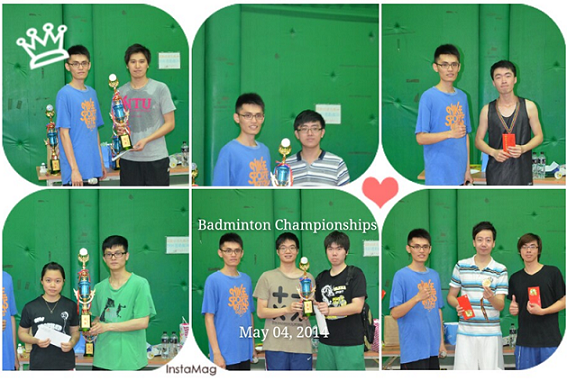 |
|
The top 3 players in the badminton tournament singles:
The champion: Li-Tien Wei
The 1st runner-up: Cheng-Chieh Lee
The 2nd runner-up: Jeng-Gang Tsai
The top 3 teams in the badminton tournament doubles:
The champion: Meng-Yu Weng, Chien-Ming Lee
The 1st runner-up: Cian-Yi Hong, Po-Han Fu
The 2nd runner-up: Wei-Hsuan Tseng, Jung-Hung Chang |
After the badminton tournament, the 2014 GIPO Cup sports games officially came to a successful close. We would like to thank GIPO teachers and office staff for your encouragement and kind support, and thanks also to participating contestants and all those who came to cheer for the games. We hope these games gave everyone a chance to stretch their limbs, and improved friendships among laboratories. Finally, we would also like to thank our Student Association buddies. It’s so wonderful to have you!
|
~ Sidelights on the 2014 GIPO undergraduates’ optoelectronics summer camp ~
(Time: August
5-7, 2014;Location:
Barry Lam Hall, NTU)
Composed by
Ting-Hao Chen, the President of GIPO Student Association
The 2014 NTU optoelectronics summer camp has come on the stage under the brilliant sun in August!
Are you feeling confused about which graduate institute you should attend, what optoelectronics graduate institutes are doing, or how optoelectronics graduates would find jobs in the future? The 2014 NTU optoelectronics summer camp has all the answers for you! In order to let undergraduates know more about optoelectronics and its industry prospects so students can make the right decisions in choosing graduate schools, we have especially organized this 3-day-camp. Participants can find answers to the above questions in lectures,
visits and interacting with GIPO students. This year we have undergraduates from many universities, most students majoring in electronics engineering or physics-related subjects, participating in the camp.
The 1st day’s 1st session was Chairman Gong-Ru Lin’s brief introduction to optoelectronics. Next was an interaction session. Participants and GIPO students were divided into 4 groups to discuss the above-mentioned questions face to face. We discovered that participants were more interested in appraisals of applications for graduate schools than anything else. Next was Prof. Hoang-Yan Lin’s lecture on the technology and industry of solid-state lighting. In the afternoon, we had Prof. Chih-I Wu giving us an introduction to light-emitting diode.
Next were the laboratory visits and hands-on experiment sessions. Participants got to know how laboratories work by visiting them and also understood a little more about optoelectronics experiments through completing the work.
Students probably felt that the 2nd day was the most fun, because we went on a field trip, visiting Lite-On Technology Corp. and National Applied Research Laboratories’ Instrument Technology Research Center; the latter is Taiwan’s important instrument research organization which develops instrument technology in accordance with our country’s technology policies. In the morning, we visited Lite-on Technology Corp., a big manufacturer of optoelectronics modules. And, in the afternoon, we visited Instrument Technology Research Center in Hsinchu.
The 3rd day’s 1st session was a special secret activity. We provided an entertaining program “super bi-i-bi” for participants to stretch their limbs. Students were inspired to strive to their utmost, in order to win the exquisite gift especially provided by GIPO. Next, Prof. Hoang-Yan Lin, who delivered the technology and industry of solid-state lighting on the 1st day, delivered an introduction to display technology and industry. Next, Prof. Chao-Hsin Wu delivered
a speech on the technology of solar cells. And, the popular Prof. Chi-Kuang Sun delivered the introduction of biophotonics technology. It appeared that Prof. Chi-Kuang Sun was very popular among students since they followed him, asking questions even when the session was over.
For our finale, we organized another entertaining program “draw & guess” as our ending session. This program demanded both drawing and guessing capabilities. Each team sent one member on stage to draw a picture concerning a specific topic designated by the organizer, and the rest of the team had to guess what the member is drawing. During the game, the whole conference room was filled with bursts of laughter and boos from time to time. Obviously, it really challenged our guessing capabilities, and we really enjoyed it.
After the last entertaining program, the GIPO Chairman Lin delivered a concluding report and conferred certificates to students. Afterward, we had an afternoon-tea party and everyone was pleasantly surprised by the great bounty of food. The winner of the “draw & guess” game was the 1st team; I was very impressed with their amazing guessing abilities. Congratulations to the 1st team; they really deserved the 1st prize. Finally, this camp came to an end after students exchanged personal information and took a group photo. We appreciated your participation in this camp very much, and look forward to see you again next year!
|
 |
|
 |
|
| |
|
 |
|
2014
International Conference on Trend, Challenges,
and Opportunities in Nano Energy
(Time: May 13, 2014;Location:
Barry Lam Hall, NTU)
Composed by
Hui-Chun Fu
The 2014
International Conference on
Trend, Challenges, and Opportunities in Nano
Energy, organized by Professor Jr-Hau He, GIPO, NTU, drew to a successful close on May 13th. This conference aggregated top scholars and engineers worldwide, including material scientists, electronics engineers, and physics scholars. It depicted the world’s future nanoenergy-technology cross-field stage, and furnished the academia-industry with a professional, multi-functional interflow platform. Through this conference, we put the most advanced technology forward to the market faster than ever before. Anyone interested in this technology, whether they are students, industrial technicians, or even investors, could use the event to create opportunities for many people, and provide great benefit for the research and development of academia and industry.
We were greatly honored to have Professor Chennupati Jagadish (Deputy Dean and Academician of Australian Research School of Sciences), Professor Paul Yu (ex-Vice President of University of California, San
Diego, President of IEEE Electron Device Society), and all other excellent academic leaders with us today to share these advanced research results. Through panel sessions, we met together to discuss the world’s hottest and most advanced subjects, to inspire more creative research ideas, and to expand interactions between fields and countries. We believe that interaction with the world’s top academicians would help us greatly in broadening our horizons, researching newer technologies, and enhancing our related knowledge. Of course, it could also inspire further ideas among nanoenergy industries, and provide young optoelectronic scientists with more knowledge and work interaction opportunities.
We would herewith like to thank EECS, GIPO, and the Office of Research and Development, NTU, for your kind assistance in preparations for this conference and for enabling it to be held successfully.
|
 |
|
From left to right, Professor Jr-Hau He, Professor Gong-Ru Lin, Professor
Ray-Hua Horng, Professor Paul Yu, Professor Jagadish, Professor Ching-Ting Lee, Professor Hao-Chung
Kuo, and Professor Jian-Jang Huang |
|
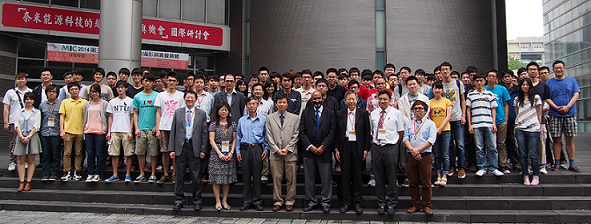 |
|
A group photo of all attending scholars, taken in front of Barry Lam Hall |
~ A visit to InnoLux Display Corporation ~
(Time: August 1, 2014)
Composed by
Tzu-Yu Chen
Participants: Chairman Gong-Ru Lin, Prof. Hung-Chun Chang, Prof. Ching-Fuh Lin, Prof. Chieh-Hsiung Kuan, Prof. Hoang-Yan Lin, Prof. Chih-I Wu, Prof. Yih-Peng Chiou, Prof. Guo-Dung Su, and Prof. Wing-Kit Choi
We recently visited InnoLux Display Corporation’s TOC factory in Southern Taiwan Science Park, Tainan. InnoLux was one of Taiwan’s most important panel manufacturers, which possessed all-inclusive continuous production lines of all sizes of LCD panel and touchscreens. By virtue of its creative research techniques, InnoLux
had sold tons of advanced panels and related
products to countries around the world. Our
visiting schedule was arranged by Jen-Yung Chang, InnoLux manager, and we were received by Wen-Chih Sa, vice president, himself. We had visited the continuous production line of touchscreens and the demo room of panel and related products. Afterwards, InnoLux’s research team and GIPO professors met to talk about the basic plans for future research cooperation, student scholarships, and academia-industry cooperation. After the meeting, this visit came to its successful conclusion. We anticipate that, through this visit, GIPO’s research cooperation with InnoLux can be firmly established and our research capability can also be effectively promoted.
|
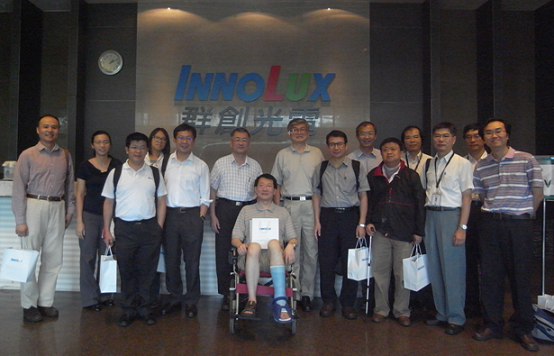 |
|
A group photo of GIPO professors, taken at InnoLux’s factory |
|
|
 |
|
 |
|
| |
|
 |
Graphene to
substrate energy transfer through out-of-plane
longitudinal acoustic phonons
Professor Chi-Kuang Sun
Graduate Institute of Photonics and
Optoelectronics, National Taiwan University
Graphene is often deposited on substrates for
practical purposes. The graphene-substrate interactions have been the focus of
many discussions because they induce property modifications and result in
considerable energy transfer at the interface. However, the proposed mechanisms
were restricted to the 2D plane and interface, while the energy conduction in
the third dimension is hardly considered. Herein, we applied nano-ultrasonic
spectroscopy with a piezoelectric nano-layer embedded in the substrate to study
the energy transfer perpendicular to the interface of the combined system of the
2D graphene and the 3D base. The result revealed energy dissipation of optically
excited graphene via emitting out-of-plane longitudinal acoustic phonon into the
substrate. We found that, under photo-excitation by a femtosecond laser pulse,
graphene can emit longitudinal coherent acoustic phonons (CAPs) with frequency
bandwidth over 1 THz into the substrate. In addition, the waveform of the CAP
pulse infers that the photo-carriers and sudden lattice heating in graphene
caused modification of graphene-substrate bond and consequently generated
longitudinal acoustic phonons in the substrate. The direct observation of this
unexplored graphene to substrate vertical energy transfer channel brings new
insights into the understanding of the energy dissipation and limited transport
properties of supported graphene.
|
 |
|
Fig. (Left)The schematic of applying femtosecond laser pulses to study energy transfer at the interface of graphene and substrate. (Right) The experimental data of differential transient transmission ( T/T) that reveals the generation of out-of-plane longitudinal acoustic phonon in the substrate by the exclusively photo-excited graphene. T/T) that reveals the generation of out-of-plane longitudinal acoustic phonon in the substrate by the exclusively photo-excited graphene. |
Reference: I-Ju Chen, Pierre-Adrien
Mante, Cheng-Kai Chang, Szu-Chi Yang, Hui-Yuan Chen, Yu-Ru Huang, Li-Chyong
Chen, Kuei-Hsien Chen, Vitalyi Gusev, and Chi-Kuang Sun, “Graphene-to-substrate
energy transfer through out-of-plane longitudinal acoustic phonons,” Nano
Letters, 1317−1323, 14, 2014
Investigation of
designated eye position and viewing zone for a
two-view autostereoscopic display
Professor Hoang-Yan Lin
Graduate Institute of Photonics and
Optoelectronics, National Taiwan University
Designated eye position (DEP) and viewing zone (VZ)
are important optical parameters for designing a two-view autostereoscopic
display (Figs. 1 and 2). Although much research has been done to date, little
empirical evidence has been found to establish a direct relationship between
design and measurement. More rigorous studies and verifications to investigate
DEP and to ascertain the VZ criterion will be valuable. We propose evaluation
metrics based on equivalent luminance (EL) and binocular luminance (BL) to
figure out DEP and VZ for a two-view autostereoscopic display. Simulation and
experimental results (Fig. 3) prove that our proposed evaluation metrics can be
used to find the DEP and VZ accurately. (Optics Express, Vol. 22, Issue 4,
pp.4751-4767, 2014.)
|
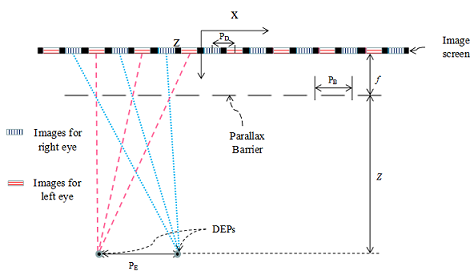 |
|
Fig. 1. Schematic diagram for a two-view autostereoscopic display design. The figure is for illustration and not to the scale. In practice, Z>>f and PE >>PD. |
|
 |
|
Fig. 2. The VZ defined by geometric line plot from side sub-pixels. The figure is for illustration and not to the scale. In practice, Z is much greater than f and PE is much greater than PD. |
|
 |
|
Fig. 3. Experiment for verifying the reconstruction map based on equivalent luminance. Calcuated peak LReq at the first lobe (+1) is at (x, y, z)= (17.5~17.75, 0, 103~104.5). The observed pictures for (a) a B/W pattern and (b) natural picture are shown at the observation point (17.5, 0, 103) marked at (c). Those for (d) a B/W pattern and (e) natural picture are shown at the observation point (15.5, 0, 103) marked at (f). |
Si and SiC
quantum dots co-doped Si-rich SiC p-i-n junction
diode with enhanced blue-green light emission
Professor Gong-Ru Lin's
Laboratory
Graduate Institute of Photonics and
Optoelectronics, National Taiwan University
Si quantum dots (Si-QDs) and SiC quantum dots
(SiC-QDs) co-doped Si-rich silicon carbide (SixC1-x) based
p-i-n junction light-emitting diodes (LEDs) with blue-green light emission is
demonstrated. By growing the SixC1-x with plasma-enhanced
chemical vapor deposition (PECVD) at relatively low temperature, the turn-on
voltage of Si-rich SixC1-x LEDs can be reduced to 6.1 V
when thinning i-SixC1-x layer to 25 nm because of higher
tunneling probability and lower series resistance. The electroluminescent (EL)
power increases to 136 nW, however, which inversely attenuates due to the
reduced SiC-QDs if the i-SixC1-x thickness further shrinks
to 25 nm. The principle EL peak at 500 nm with narrower shape and blue-green
emission pattern is attributed to the self-trapped excitons at surface states
among SiC-QDs. The external quantum efficiency (EQE) of the Si-rich SixC1-x
LEDs with i-SixC1-x thickness of 50 nm is up to 1.58×10-1%
with enhanced carrier tunneling probability. The carrier injection efficiency is
enhanced to 46% by increasing the doping concentration to 1016
cm-3, leading to almost one order of magnitude improvement on
the EQE of Si-rich SixC1-x LEDs.
|
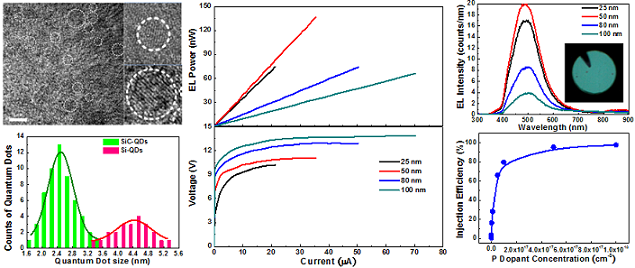 |
|
Figure Left: The TEM images (Upper) of the Si-rich SixC1-x films (Left) with co-doped SiC-QDs and Si-QDs in average sizes of 2.5 nm and 4.3 nm, respectively with the size distribution (Lower) of SiC-QDs and Si-QDs in the Si-rich SixC1-x film with the thickness of 50 nm. Middle: The I-V (Lower) and P-I (Upper) characteristics of the Si-rich SixC1-x p-i-n junction LEDs with different i-SiC thickness grown with the fluence ratio of 60%. Right: The EL spectra (Upper) of Si-rich SixC1-x p-i-n junction LEDs with the different i-SixC1-x thickness. Inset: the EL emission pattern. The carrier injection efficiency (Lower) of the Si-rich SixC1-x p-i-n junction LED as a function of n-type dopant concentration under fixed B2H6 doping concentration. |
Reference: Hung-Yu Tai, Chih-Hsien
Cheng, and Gong-Ru Lin, “Blue-Green Light Emission from Si and SiC quantum dots
co-doped Si-rich SiC p-i-n Junction Diode,”
IEEE J. Sel. Top. Quantum Electron.,
Vol. 20, Issue 4, 8200507, Jul.-Aug. 2014.
ITO-free
low-index transparent electrodes for enhancing
light out-coupling of organic light-emitting
devices
Professor Chung-Chih Wu
Graduate Institute of Photonics and
Optoelectronics, National Taiwan University
The transparent conductor indium tin oxide (ITO) has
been widely used in organic light-emitting devices (OLEDs) and other
organic/inorganic optoelectronics as the transparent electrode. ITO, however, is
rather expensive and thus not cost-effective due to scarcity of the indium
element on earth. ITO is also brittle and usually requires high-temperature
processing, limiting its compatibility with flexible plastic substrates and thus
its use for flexible devices. Accordingly, in recent years, alternative
(ITO-free) transparent conductors/electrodes for replacement of ITO are being
intensively pursued. Through our studies, we have developed high-conductivity
conducting polymers having excellent mechanical flexibility, good transmittance,
solution processing capability, and low cost. Most importantly, they possess
high conductivity of up to ~1000 S/cm, similar to that conventional ITO and
sufficient to replace ITO as alternative transparent electrodes in various
optoelectronic devices. Intriguingly, such high-conductivity conducting polymers
also possess an optical refractive index significantly lower than those of ITO
and typical organic layers in OLEDs and well matching those of typical OLED
substrates. Optical simulation reveals that by replacing ITO with such a
low-index transparent electrode, the guided modes trapped within the organic/ITO
layers in conventional OLEDs can be substantially suppressed, leading to more
light coupled into the substrate than the conventional ITO device (Fig. 1). By
applying light out-coupling structures onto outer surfaces of substrates to
effectively extract radiation into substrates, OLEDs using such low-index
transparent electrodes achieve much enhanced optical out-coupling and
electroluminescence efficiencies (EQE up to 45%, luminous efficiency up to185
lm/W) in comparison with conventional OLEDs using ITO (Fig. 2).
|
 |
|
Fig. 1. Calculated mode distributions (fraction of radiation coupled into different modes) of OLED internally generated radiation |
|
 |
|
Fig. 2. External quantum efficiencies and luminous efficiencies of various devices |
Role of Cathode
Connecting Layers and Energetic Alignment in
Organic Photovoltaic Devices
Professor Chih-I Wu
Graduate Institute of Photonics and
Optoelectronics, National Taiwan University
Open-circuit voltage is one of the key parameters
affecting the performance of organic photovoltaic devices. Several electronic
mechanisms originating from energy band alignment within the path of charge
transport and carrier extraction are the major factors that limit the Voc.
We demonstrated that the influence of energetic disorder due to introduced
cathode buffer layers between active layer and metal cathode can contribute to
energetic favorable charge transport and extraction, leading to Voc
enhancement. To explore the dependence of Voc on the energetic
properties of the contacting materials prior to cathode deposition, we proposed
a comprehensive model for buffer layers based on molecular materials commonly
employed in OLED and OPV cells.
Energy band alignment of various cathode buffer
layers in P3HT/PCBM based bulk-heterojunction (BHJ) solar cell are checked via
in situ
ultra-violet photoemission spectroscopy (UPS) and the results are organized as
follows: First, we clarified the correlation between charge transport property
and carrier extraction ability at buffer layers with energetic favorable band
alignment. This includes a presentation of qualitative models for the dependence
of HOMO and LUMO offset between active layer and buffer layer on the shunt
resistance and series resistance, and short-circuit current density, or
saturated value of Voc based on Shockley’s theory for p-n junctions.
Second, the dependence of Voc and OPV operating parameters on the
cathode contacting materials with inappropriate energy offset or transport
ability, such as narrow band gap and hole transport materials, were obtained. We
investigated not only the LUMO offset related to electron transport, but also
the influence of HOMO offset on carrier extraction at cathode contact.
Experimental details and device performance are provided in our recent
publication. As a result, the performance of P3HT/PCBM based BHJ solar cells
with various buffer materials can be classified into three class according to
the energy offset. Class I contained large HOMO and LUMO offset so the better
hole blocking and electron transport ability lead to a saturated value, 0.6 V,
of Voc in P3HT/PCBM system. Class II has either large HOMO offset or
LUMO offset making a small decrease in Voc and a poor Voc
for Class III due to inappropriate energy offset of buffer materials. Finally,
we summarize the key findings to propose and verify a new model which gives
predictions for the maximum Voc in BHJ solar cells consisting of
buffer materials.
Organic solar cell with 95.6% internal
quantum efficiency
Professor Jiun-Haw Lee
Graduate Institute of Photonics and
Optoelectronics, National Taiwan University
With suitable device and fabrication design, an
organic solar cell (OSC) with 95.6% internal quantum efficiency (IQE) was
demonstrated with boron subphthalocyanine chloride (SubPc) and C60 as
the electron donor and acceptor materials, respectively. To improve the open
circuit voltage (VOC), SubPc/C60 heterojunction structure
was employed. Suitable deposition rate of SubPc was needed between the tradeoff
between VOC and fill factor. 3-nm N,N-dicarbazolyl-3,5-benzene (mCP)
was inserted between indium-tin-oxide (ITO) anode and SubPc which served as the
exciton and electron blocking layer. Combined with layer thickness optimization,
IQE of such an OSC reached 95.6% at the absorption peak 590 nm.
|
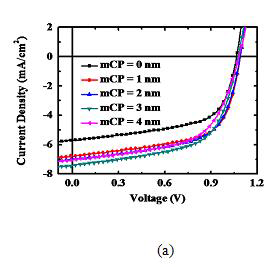 |
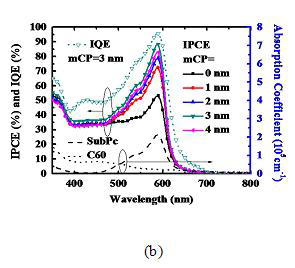 |
|
Fig.1. (a) J–V characteristics and (b) IQE of OSC with different mCP thickness |
|
|
|
 |
|
 |
|
| |
|
|
 |
|
 |
|
|
|